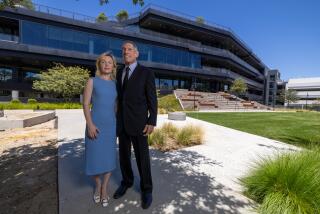IRVINE : Medical School Gets Money for Building
- Share via
Philanthropists Joan Irvine Smith and Athelie R. Clark have donated $2 million to the UC Irvine California College of Medicine toward the purchase of a privately owned research building on the campus.
At a university where research space is limited, the 6,000-square-foot building, with its built-in laboratories and space to add several more, will meet a tremendous need, Dean Walter Henry of the medical school said Thursday.
Also, for the first time, UCI scientists doing basic and clinical research into schizophrenia, Alzheimer’s disease and other areas of neuroscience will work in the same building, Henry said.
“We hope to close escrow before the end of the month and occupy the space by the first of the year,” Henry said.
A subcommittee of UC regents accepted the gift from the Joan Irvine Smith and Athelie R. Clark Foundation at its regular meeting Thursday. The full Board of Regents is expected to approve it today.
Under terms of the gift from Clark and Smith, who are mother and daughter, the foundation will pay for nearly half the building’s $4.9-million purchase price. The remaining $2.9 million will be covered by a loan to be paid back by the UCI campus and the medical school, Henry said.
Located in the center of the medical school campus, the research building has sat nearly vacant for about a year. The ground floor of the building has continued to be used by researchers from the medical school’s Brain Imaging Center.
Once called the Nelson Research Building, it was constructed seven years ago by the Nelson bioscience firm. Under its arrangement with UCI, Nelson constructed the building and agreed to a 30-year ground lease from the university, including an agreement allowing UCI researchers to occupy 28% of the building.
Nelson later was acquired by the Ethyl Corp., whose Whitby division continued drug development work in the building until last year, when Ethyl consolidated its activity in Virginia. Since then, the upper floors of the building have been nearly vacant except for one or two researchers, Henry said.






